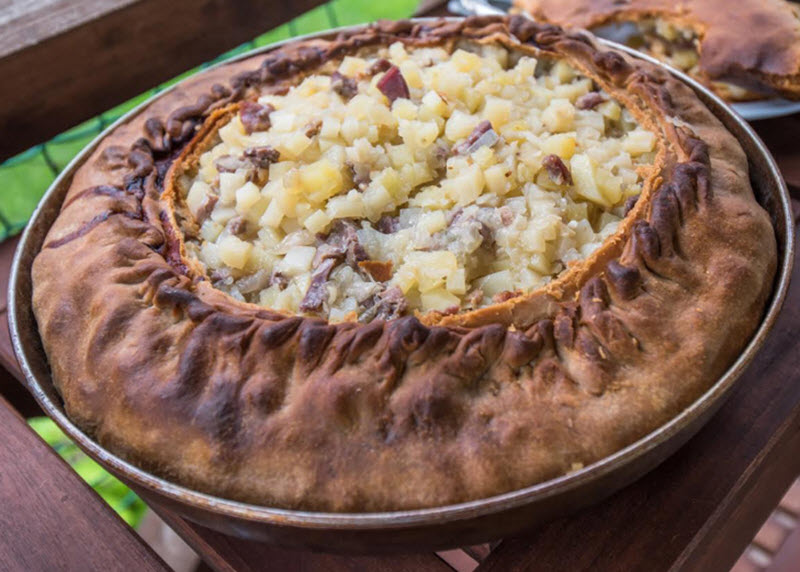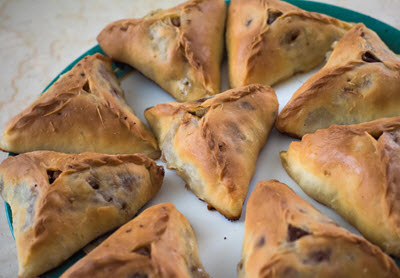
The cuisine of the Volga Tatars is closely linked to that of the Volga Bulgars, and has also been influences by other ethnic groups living in the same region as the Volga Tatars, such as Russians, Mari, Udmurts, andUzbeks.
The five staple categories of Tatar cuisine are:
- Hot soups
- Main course dishes which typically include meat, grains and root vegetables
- Baked items with a savory filling
- Dough-based dishes (e.g. noodle dishes)
- Sweet items, including baked sweets
History
On this page:
The Volga Tatars settled down in a region where two different environments meat – the norhern forest and the southern steppe – and these two habitats have both been instrumental in shaping the cuisine. The traditional home of the Volga Tatars is also where two larger rivers flow – the Volga and the Kama – and this encouraged trade which brought in ingredients from far away.
If we go back in history, we can see that the Volga Tatars relied heavily on their livestock and cereals to survive. When it comes to meat, both beef, mutton and horse meat have historically been important for the Volga Tatars, and are still present in many of the main dishes today. (The horse meat is usually prepared by boling and curing it, to make .) The farms also raised poultry, typically hens, duck and geese. Eggs are included in many Volga Tatar recipies, and are prepared in various way, including boiling, baking, frying and including them in noodle dough.
 Bovines were not just kept for their meat, but for their milk as well, which was turned into dairy products such as sour cream and curds.
Bovines were not just kept for their meat, but for their milk as well, which was turned into dairy products such as sour cream and curds.
Growing vegetables was less common than growing cereals, but root vegetables such as turnips, beets, carrots, onions, and horseradish were cultivated. There is also a traditional of growing cabbage and cucumber, but only in small quantities. From the end of the 19th century, the potato became very important.
Examples of important grains: rye, millet, buckwheat, oats
Orchards created along the right bank of the Volga River provided fruits and berries such as apple, cherry, raspberry, and currants. In the northern forests, one could forage for wild food such as walnuts, leeks, and cow parnsip.
Bee hives were kept to provide honey.
Today
Today, modern life has influenced Volga Tatar cousine in various ways, often in the form of new ingredients being added to traditional dishes. Mushrooms and pickles are for instance eaten today, especially among urban living Volga Tatars. Also, fish has become more commonplace than before, which is a bit odd when you consider how close the Volga Tatars have always been to the rivers Volga and Kama.
Trading with tropical locations has brought in exotic produce such as kiwi, mango and bananas.
Volga Tatar soups
The soups are divided into subcategories based on their style of broth. The broth, which is known as şulpa, can be made from beef, poultry, fish, vegetables, etc.
Soups often contain grains, homemade noodles, root vegetables and/or vegetables, and tend to be served with either meat balls or stuffed buns.
For celebrations, it is popular to serve a clear soup together with meat-filled dumplings known as pilmän. The soup is made tastier with the addition of dill or other fresh herbs.
Main courses
The main dishes are usually based in meat, grains and (since the late 19th century) potatoes.
Here are a few examples:
Bäliş
Bäliş is a dish where pieces of fat meat are combined with millet, spelt or rice, and baked in a crock. Beef, mutton and goose are just a few examples of commonly used meats. Duck innards are another traditional choice.
Tutırma
Combine finely chopped liver with millet or rice, and place in a well-cleaned intestine.
Tutırğan tawıq
A chicken is stuffed with eggs in milk. This dish is normally only made for special celebrations.
Bişbarmaq
This is a dish where boild meat is served with noodles. Various versions of it exist among most of the Turkic peoples who inhabit Central Asia and Russia, and it is believed to have been a part of Turkic cuisine as early as the nomadic era.
While the meat is being boiled, you prepare noodle dough from flour, water, eggs and salt. Leave the dough to sit for at least 40 minutes, before rolling it out and cutting it into thin noodles. Take out the meat from the broth and cut it into small pieces. Put the noodles in the broth and boil them for 5-10 minutes.
Boiled noddles and finely chopped boiled meat are placed on a tray. Onion sauce containing onions, meath broth and pepper is a popular addition to provide more flavor. Mix everything together before serving.
Bişbarmaq is sometimes served with qazi, especially during celebrations. Qazi is a type of sausage and is made by placing horse meat inside an intestine.
Pilaw
Pilaw is a flexible rice dish with Indian origins that was incorporated into Volga Tatar cusine a long time ago. It comes in many different variants, reflecting local preferences, economy and availability. It is a popular dish at larger gatherings, since it is easy to prepare for a crowd.
Many other cuisines around the world contain essentially the same dish, often under the name pilaf or similar.
Bread
Unleavened dough is traditionally used to make not just flatbreads, but also biscuits and buns. The buns have either sweet or savory filling.
Bread made from leavened yeast dough is a standard side-dish for meals. Traditionally, the bread was made from rye. Wheat bread was reserved for the rich or for special occasions.
Baked sweets
Volga Tatar cuisine contains many different baked sweets, which are traditionally served with tea.
Examples:
| Name | Info |
| çäkçäk | Sweet pastry balls that form a mound and are drenched in honey.
This pastry is common throughout the Turkic peoples. |
| çelpek | A type of deep-fried pancakes |
| lawaş | Fried dumplings filled with raisins |
| paştet | A sweet pie.
Jam or dried fruits are common fillings. |
| qatlama | A filled baked roll.
Many different fillings exist, such as qort, nuts, poppy seed, and sesame seed fillings. Qort is made from drained fermented milk. |
| qoş tele | Deep-fried squares or diamonds of unleavened dough.
The name means bird’s tongue. |
Beverages
Hot, strong tea is a very important beverage among the Volga Tatars and visitors will definitely be offered tea by the host. The tea is customarily served with milk, sometimes also with honey. The tea cups are small and low.
Äyrän is a beverage made by diluting sour milk with cold water.
Quas is a beverage that entered the Volga Tatar kitchens through contact with ethnic Russians. It is made from rye flour and malt.
Until the early 20th century, şirbät was only used as a ceremonial beverage. At weddings, the “bride’s sherbet” would be served in the home of the groom. The drink is made from honey. Today, it is drunk even outside ceremonies.